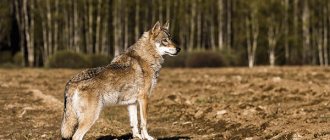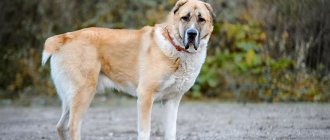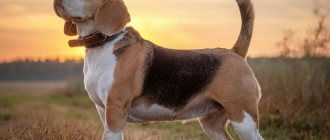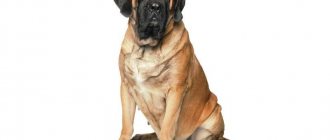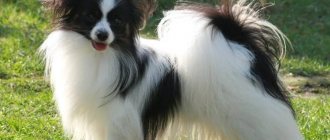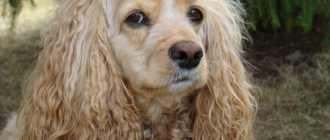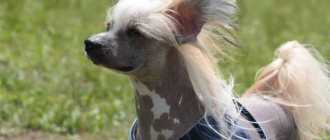Did you know that wolf-dog hybrids are... excellent diagnosticians who can detect cancer in a person by the smell of blood? By the way, the wolfdog breed itself is distinguished by excellent health. But these are not all its advantages. Crossing a wolf with a dog is real. It is quite possible for a wolf to have offspring with an Alaskan Malamute or Husky. But only a hybrid of a shepherd and a wolf is considered a real wolf-dog. These include only two types - Czechoslovakian Wolfdog and Saarloos Wolfdog. The breed is not recognized by the Fédération Cynologique Internationale.
History of the breed
Scientists believe that the first time a person tried to cross a dog with a wolf about 10 thousand years ago . But the end result was difficult-to-train, rather aggressive animals.
The first more or less successful attempts began only in the last century. So, in 1925, Lander Sarlos received his first litter from a shepherd dog and a domesticated she-wolf, Flora. The Saarloos wolf dog is quite popular in its homeland, it is used as guide dogs or bloodhounds. The Saarloos wolf dog is not very suitable as a working dog.
The Kunming Shepherd was developed in the mid-1950s. Outwardly, it looks like an ordinary shepherd, but only with long legs. Outbred dogs were used for breeding.
In the middle of the last century, Czechoslovakian Colonel Karel Hartl was involved in breeding shepherd-wolf hybrids. In 1989, the Fédération Cynologique Internationale recognized a new breed – the Czechoslovakian Wolfdog was classified as a herding breed. Today she is considered difficult to educate. There were experiments in Russia, for example, dog handlers from Perm did this. But the most successful attempt is a hybrid of the titled male Schnapps and the tamed she-wolf Naida . This was in the early 2000s.
Any breed that has at least 10% wolf blood . The amount of blood can be determined by the prefix with the letter F: if one of the parents is a wolf, the dog is given the marking F1, F2 means that the puppy’s grandmother was a wolf. Other varieties include the Haskovolf, Swisswolf, Wolfhund and Wolamute .
The reason why the IFF does not recognize wolf-dogs may lie in the fact that they have a difficult character and are difficult to train. Perhaps over time this problem will be solved. Despite everything, the wolf-dog hybrid is popular: many nurseries successfully breed and sell them.
Labrador
The second most popular dogs in the world are Labrador Retrievers. This type was specially selected as assistants; they are also called gunmen. Television shows more than once how Labradors take part in rescue operations to find people after avalanches, after earthquakes and after other natural disasters. The Labrador also does an excellent job as a guide dog for people with disabilities.
Labski is a mix of Husky and Labrador
Like half-breed huskies, labskies, they look like a wolf, their temperament is very aggressive, complex and independent
Given these character traits, you should pay attention to training your pet from infancy. As in a pack of wolves, a person must show that he is the master, he must prove his primacy: always go out the door for a walk first, Husky should eat only after the person himself has eaten
Interesting Facts
- In 2010, 300 thousand wolf-dogs were registered in the world;
- The more dog blood, the more aggressive the wolfdog;
- These animals can easily live in an apartment, but feel best in a private home;
- A cross between a shepherd and a wolf is better trained by women than by men. There are no explanations for this feature yet;
- Their favorite delicacy is not meat, but... sweets. They go crazy over sweets, marmalade, marshmallows, chocolate;
- *The highest quality hybrids are obtained if the father has a balanced character and is loyal to people;
- They love to lick their owner's teeth...
- There is no rabies vaccine for wolfdogs;
- They howl more often than bark.
Owner reviews
Yuri: “Such an animal lived in our service. I arrived at the border at 18 and left at 32. So we were together all the time and got along very well. Of course, you can't relax. But he fell in love with the dog. There’s nothing scary with her.”
Valentina: “One day we were walking with my husband and daughter and went to the poultry market. There the girl gave very cute puppies. We took a closer look, but didn’t like the mouth - the fangs were too scary. And then he told us that it was apparently a cross between a wolf and a dog. It's really really scary! They were also sold without documents and certificates, so they ran away from there without looking back.”
Vladislav: “We live in a private house outside the city, there are no other houses nearby - only the taiga. A colleague sent me a photo of a huge dog, I couldn’t stop looking at everything. Then he said that it was a cross between a wolf and a dog, and offered to buy a puppy. The price, of course, is astronomical. It was both scary and interesting. In general, we agreed that I would take the puppy, but if something goes wrong, I could return it. As a result, the dog grew up, he was affectionate with us, but if one of the dogs wanders around the yard, it means he is gone! I ripped apart all the dogs in the neighborhood that I had to give up. I feel sorry for them".
Konstantin: “I live in a village, and we have more than enough bandits here! The thieves especially woke up when I went to work for 2-3 months, and my retired mother was left alone. She called, complained, cried: either the lock on the gate was broken, or the barn was broken, and that in itself was scary. I bought her a Wolfhund, built her a kennel and started teaching. Since childhood, I tried to be tougher on him so that I would know who was the boss. I walked around the area a lot, but always returned safe and sound. During my departure I had to keep the dog in a kennel; my mother was afraid. We hired someone special to come hang out. The defender has a 5+, but, of course, it’s scary to approach him every time. You cannot escape wild blood."
Karina: “My daughter is a typical “little girl”; she played football from an early age and dreamed of a big dog. One day I brought home a small fluffy puppy. They couldn't refuse with their father, they left. It seems that the dog is smart and decent, but his behavior has become clumsy: he will sit by the door and begin to howl, so to speak. I've already tried everything, and I whimpered like I whined. They took me to the vet and thought it might hurt somewhere. And the doctor looked at us laughing. He says that this is a wolf dog, this is the norm for him. Then I thought about killing my daughter. But they did all the tests, gave us the contact information of a good wolf dog handler, and raised an excellent dog. However, he had to get rid of him when he grew up: he was cramped in the apartment. He was handed over to the police."
Description of the breed
Outwardly, they most resemble a wolf, especially if it is a hybrid with a husky or shepherd, but the genes take their toll: they are smaller in size. So, an adult male at the withers has a height of up to 60 centimeters and a weight of up to 50 kg. Bitches weigh up to 40 kg and height up to 55. They usually have a strong and massive build, strong paws and powerful jaws. Most often the animal has a wolf bite, which is why they are stronger than any dog.
Sometimes you come across particularly large individuals with a height at the withers of up to 75 centimeters . Wolf genes play a role here.
Wolf dogs adapt quite easily to changes in life. The character and appearance of a dog most of all depends on how many wolf genes they have, on what breed took part in the crossing. But in general, their strengths are several. So, they have excellent health; such hybrids are not prone to “canine” diseases . They are ready to faithfully protect not only the house, but even the owner’s car, not to mention the owner himself. Usually they are equally attached to all family members, but they still treat women better. Another advantage is their ability to observe - the wolf dog perfectly sees strangers on its territory.
They need special training. You must understand that you adopted a wild animal, and not a domesticated one, even if it was many thousands of years ago. The most aggressive animals are those that have more than 20% wolf blood and those that have lived in a confined space for a long time. Wolfdogs are not recognized by the International Canine Federation, but this does not mean that they do not have standards. Yes, they look like wolves, but there are still differences.
Color
Gray, but a lot depends on what breed the wolf was crossed with. The more wolf blood, the darker the animal will be. Spotted and off-white colors are also found. Rarely, but there is a black wolfdog.
If this is a classic wolf-shepherd hybrid, then typical shepherd colors are possible:
- Black-and-white. The top is a dark V-shaped spot on the sides, belly and top of the tail. The bottom is lighter. May be fawn, light brown or light grey.
- Zonal. This color is also called wolf color. At the base the coat is light, then dark, then yellow and dark tips. The shade can be any.
- Black. There should be no light marks here. If crossed with a Belgian Shepherd, the wolfdog may have a yellowish-brown color.
Standards
Animals are tough. With well-developed muscles and a lean figure. The sizes are large, the skeleton is strong.
Head
The forehead is in the shape of a blunt wedge, quite wide. The muzzle is elongated, wolf-like. The nose is straight, expressive, the skull is wide. The eyes are almond-shaped, small in size, and the iris is amber. The gaze is studying and wary. The bite is either pincer or scissor. The ears are set high, medium in shape, pointed, triangular.
Neck
The dog has a rather long, strong neck. The neck is very muscular, slightly expanding towards the body.
Body
The body of the wolf-dog is rectangular, lean, muscular. It has a straight back with lean sides. The croup is powerful and the transition to it is smooth. The paws are longer and larger than those of a dog.
Tail
The dog-wolf hybrid has a thickened and long tail part of the spine. The landing is high. The tail is lowered down in a calm state. It cannot be stopped.
Limbs
As mentioned above, wolf-dogs have muscular and long, slightly closer paws.
Movements, plastic
Wolf dogs are very mobile, they can easily cover long distances. They jump high and run fast. While moving, the wolf-dog powerfully pushes off the ground, placing its limbs parallel to each other.
Wool
Thick, fits tightly to the body. The guard hair is smooth, straight, hard. There are more dense parts on the inner thighs and neck. Wolf dogs have a soft and thick undercoat. Occasionally, long-haired wolf dogs are found.
Character
Most of all, the character of a wolf-dog depends on how many wolf genes have been passed on to it. But there are also common features. This breed is most suitable for official purposes. What is definitely not in their nature is uncontrolled aggression. It manifests itself only with improper upbringing, so it all depends on the owner. The wolf dog easily tolerates cold and hunger . It can dull the feeling of hunger and survive even a long hundred-kilometer hike. In general, a wolfdog and a human may well be friends and collaborators.
It is difficult to predict the character of an animal even if wolves with a stable character took part in the crossing - puppies can still be born aggressive or timid .
The most “successful” hybrids are those with excellent instincts , which are actively used during search operations. They can also dominate their owner. If several animals live in a house, they either do not get along with them or become leaders. In other cases, they, like ordinary dogs, choose a leader - an authority figure in the family . If the owner lacks leadership qualities, the wolfdog may become an uncontrollable animal and simply not recognize a person with a gentle character.
Nicknames
For boys
- Link
- White
- Wolf
- Hans
- Grey
- Dante
- Casper
- Lloyd
- Maurizio
- North
- Poulion
- Rocky
- Walter
- Hardy
- Hunting
For girls
- Alma
- Beta
- Bertha
- Vega
- Vicki
- Gerda
- Jess
- Casey
- Cleo
- Leela
- Ollie
- Party
- Elf
- Tressy
- Cherry
Health and illness
Wolf dogs differ from dogs in excellent health. This is due precisely to wolf genes. They do not need regular vaccination, and some experts believe that vaccines do not work on wolves. According to dog handlers, hybrids need the help of a veterinarian three times less often than a regular dog. Many of them live 20 or even 30 years , maintaining an excellent sense of smell and vigor until a very old age, which allows them to serve for many years without respite. However, sometimes they have diseases characteristic of shepherds.
Cataract. Treatment consists of constant instillation of various taurine-based drops. This needs to be done daily and for many years.
Anomalies of the skeletal system. This occurs if the animal’s muscles are inherited from a wolf, and its bones are inherited from a dog. Sometimes this leads to deformity. The congenital disease is poorly treatable. A diet rich in calcium and vitamin D can help.
Cryptorchidism. It occurs when one or two testes do not descend into the scrotum. The disease is hereditary. It is treated either by plastic surgery or by injections of testosterone and gonadotropin.
Gastrointestinal diseases. Appear as a result of improper feeding. Treated with diet correction.
Joint dysplasia. They make themselves felt in the form of lameness, severe pain and inflammatory processes. Often treated with surgery or diet and vitamin D supplements.
Rabies. It cannot be treated and is fatal.
Also, wolf-dog hybrids may have diseases of other breeds, depending on who the wolf was crossed with.
German Shepherd
Everyone is well aware of the unsurpassed qualities of the German Shepherd; they have rightfully earned primacy among service breeds. Easy learning and unsurpassed intelligence make it possible to use them in a wide variety of areas of human life. In addition, shepherd dogs also get along well as companion dogs; they are not aggressive and get along well with children. Purebred German Shepherds win many medals at international dog shows.
Shepsky is a cross between a German Shepherd and a Husky.
The shepherd-husky mix gives rise to a new species called the Shepsky. These half-breeds will be excellent guards for your home. But everywhere has its downsides, and it is a sense of proportion regarding their property that can reveal the most negative character traits. A German Shepherd and a Husky provide you with a reliable and loyal guard, but you shouldn't leave a Shepsky, for example, alone with newly arrived guests or with a loud crowd of children. Having accepted any actions in their direction as a threat, the Shepski will not hesitate and will immediately attack the stranger. During meals, these half-breeds are also very irritable. Half-breeds from a shepherd are best used for official purposes.
Upbringing
It is believed that the more wolf genes a representative of this breed has, the more difficult it is to raise him. In fact, even in one litter there can be both docile animals and wild ones with a wolfish character. Education is usually carried out by professionals, and it is aimed at developing service qualities - after all, this is not a couch potato, moreover, they are very active and willful. But what else can wolves be?
Wolf dogs are nocturnal animals, so it is best to train them in the evening.
- If you nevertheless decide to have a hybrid of a dog and a wolf not for service, but for friendship, then you need to educate him from the very first days .
- The main thing they need is constant contact with a person , preferably a kind but strict one.
- They definitely need to be tamed to human hands.
- It will be good if the puppy has contact with peace-loving ordinary dogs. Still, it is better to entrust this process to a professional. Perhaps his educational measures will seem harsh to you, but this is the nature of the breed.
- They do not have a close connection with a person , but this is good for the service, because one owner here can easily replace another.
- You need to treat the animal with firm respect , and he simply will not tolerate beatings and humiliation.
Why don't all people trust?
This is due to the character of the wolf. In ancient times, the wolf trusted only those who could tame it, bypassing the others. This quality has been preserved among wolfhounds.
Wolfdogs are "famous" for their lack of affection. In fact, animals were created for the purpose of being used for service and protection, where attachment to a human could interfere with the work. Unlike domestic “relatives”, the wolfhound will not be deprived of his owner and all his feelings, as well as brain activity, will be aimed at fulfilling his official duties
However, reading special forums, we see many refutations of this fact.
Maintenance and care
This breed is clearly not for home keeping. Therefore, he needs a warm booth and an impressive enclosure . As a last resort, you can let the dog-wolf warm up in the dressing room in the most severe frosts. But he needs a lot of personal space, so before buying you need to organize a large yard . It will be good if there are several exercise equipment for dogs , since the animal is very active. They usually tolerate low temperatures and rain well, as well as heat.
The yard must be well fenced so that the wolf dog cannot leave the site. This breed is prone to wandering and can become attached to stray dogs or even its own blood brothers. In addition, they have a developed hunter instinct, so they need to protect their neighbors as well.
Hygiene rules
Wolf dogs do not require special care; they are quite unpretentious, like all wild animals. But they have one peculiarity. They shed twice a year, and during this time the coat should be looked after quite intensively. Otherwise, caring for a wolfdog is almost the same as caring for a regular dog.
The animal should be accustomed to hygiene procedures from the first days. It will be difficult later.
The coat is combed once a week. But if shedding occurs, it is best to do this every day.
Bathing is recommended once every 6 months.
your teeth , but you need to purchase bones specially designed for cleaning teeth at a veterinary store.
The eyes should be examined every day, removing discharge as necessary.
your ears every three to four days. If you're worried about ear discharge, it could be an infection, so it's best to go to the vet.
claws , as they grind down on their own.
Nutritional Features
Wolf dogs are not particularly whimsical in food, because in nature they are quite omnivorous. For the same reason, you should not feed them wet and dry food, even holistic food - they can harm the animal’s health. So only natural nutrition , but it is important that protein significantly predominates over carbohydrates .
- It is recommended to feed your pet boiled meat with the addition of cereals (buckwheat, oats).
- It is better not to give meat raw.
- By-products are acceptable.
- The wolfdog's menu should also include vegetables, preferably boiled ones.
- You can give sweets and brain bones as treats.
Prohibited: nuts and legumes, garlic, millet, acorns and grapes.
You need to feed the wolf-dog once or twice a day. Puppies are fed six times a day.
Walks
The breed is in no way suitable for an apartment, so there is no question about walking. If you decide on such an adventure, then be prepared for four-hour walks for 20 years, or even more, and very active ones. A good option is to tie him to a bike and make him run. Moreover, the most active walk should occur in the evening.
Training
- Only a master with extensive experience should do this. But if you have raised more than one dog, you can supplement the training of a professional and take master classes from him.
- The animal has a wolfish character and habits. They are peaceful animals, but unpredictable and cunning. You need to be smarter than the wolf.
- When exercising, you should always have a treat with you, and this is not dry food. Ideally something sweet (they love it) or a marrow bone. In order not to be left without a finger, feeding is given in a fist.
- Train your wolf through play. He definitely won’t perceive you as an authority if you show aggression and beat him. First, achieve obedience, and then you can begin full training. But you must have a strict attitude.
- During training, you need to teach him to walk next to the owner, show his teeth, and approach the owner.
- First of all, you need to teach him simple commands: “Ugh!”, “Stand”, “Sit”, “Lie down”.
- You definitely need to master overcoming a barrier, a ladder, a fence, a boom and an inclined wall.
- Skill training should take place in any order.
- In the first lessons, you can study two teams per lesson, then their number can be increased.
Nutrition for mixed pets
Mixed-breed dogs require a rational, balanced diet, taking into account the nutritional value and calorie content of foods
It is especially important to feed puppies adequately, since the correct development of the skeletal and nervous systems is laid down in childhood. Lack of essential microelements can lead to rickets in your pet.
Note! The daily nutritional intake, taking into account the necessary vitamins, macro- and microelements, is difficult for a non-professional to calculate. The veterinarian will help you create a complete menu for your pet.
The diet of mixed breeds is compiled taking into account the dog’s weight, its metabolism and the characteristics of the parent breeds. The husky-shepherd mix has a fast metabolism, moves a lot and has a good appetite. She is fed natural food, which contains:
- cereals;
- dairy products;
- meat;
- cereals;
- vegetables;
- meat by-products;
- vitamin supplements and minerals.
A puppy needs dairy products for normal development.
It is also possible to include high-quality dry food in the diet, which contains a balanced daily intake of nutrients. Mixed-breed puppies are fed three to four times a day; an adult animal needs two meals a day.
How to choose a puppy
It is impossible to buy such an animal in official nurseries, since they are bred only by law enforcement agencies for service. However, for 10 thousand rubles you can buy it in an unofficial nursery. A wolf dog with a strong psyche will cost 50 thousand or more . Things to consider:
- Percentage of wolf genes in the litter. The smaller it is (but not less than 10-20% ), the greater the chance that you will buy a dog and not a wild wolf;
- Pedigree. Find out how purebred the shepherd was that took part in the crossing.
- Puppy temperament. It is best to choose the calmest one, but definitely not the most apathetic one.
Wolfdog is a complex breed. But it has its own characteristics. The fewer wolf genes you have, the more likely you are to have a dog rather than a wild animal. They are not suitable for apartment living. They need a spacious yard with a warm booth. They are unpretentious in care, but need natural nutrition. Only a professional should train him. If you are not a professional, but have raised several dogs, you can decide to experiment by raising a loyal friend.
Natural enemies of the wolfdog
Photo: What a wolfdog looks like
Wolf dogs raised in captivity show strong aggression towards almost everyone - they cannot tolerate wolves, dogs, or people. Wolf-dogs gathered in a pack are especially dangerous. Packs of these animals can easily attack even a group of armed people, showing rare ferocity and detached courage. They are not afraid of gunshots, screams, flames or smoke.
Therefore, the wolf-dogs themselves, living in the wild, can safely be called enemies of all living things - packs of mestizos attack even such large animals as elk, wild boar or bear. They are also dangerous because they retain amazing sensitivity to various kinds of poisons - the wolf dog will not even sniff the bait that an ordinary dog would swallow without a second thought.
A properly raised and trained domestic wolf dog will become “another member of the family” - like huskies and malamutes, these animals get along well in the family. But at the same time, the wolf-dog will always remain an unsurpassed guard (note that most often these animals keep watch in pairs). And if an uninvited guest, if discovered by a dog, first hears a loud bark and roar, then the wolfdog in this case will not make a sound, attacking from behind.
Wolf dogs are pack animals, so they easily get along with other dogs in the same territory. In order to eliminate any possibility of misunderstandings between your pets, it makes sense to buy and raise them together. Then they will get used to each other and begin to consider themselves members of one pack, the undisputed leader of which can only be the owner. Otherwise, it will be an uncontrollable pack, the presence of which will become dangerous for people.
Appearance
The description of the breed is rather short and mediocre. The wolf dog should resemble a wolf in appearance and be large in size, the dimensions range within the following ranges:
- Height: 62–67 cm.
- Weight: 35–45 kg.
The build is identical to a wolf - a “dry” body structure, flat, toned sides, strong jaws with a “death grip”, a very large hand, long and sinewy limbs. The color is gray (wolf), all shades and varying degrees of color saturation are allowed.
If we move away from the rigid framework of cynology, a Wolfdog can be called any dog in whose veins the blood of a wolf flows. Fans of “outlandish” four-legged animals do not like to clarify what the percentage of “wild and domestic” blood is in their pet; the fact itself is important. Thus, in various sources you can find dogs with the same name, but completely different characteristics. For example, a peach or white Wolfdog, whose color pattern resembles a Belgian Shepherd, and the German exterior is obtained by multi-stage mating of Huskies, Laikas and the same German Shepherds.
Black Wolf Dog obtained by crossing a wolf and a German Shepherd. To be fair, we note that the chances of being closely related to a wolf are much higher for dark-colored individuals than for peach or white ones. The only and unshakable condition for all Wolfdogs is a domestic, adequate and balanced character (this condition does not apply to dominant sexual aggression).
Special parameters
What makes the wolfdog unique is its keen sense of smell. The animal is so intellectually and physically developed that it is able to distinguish a sick person from a healthy one, and can detect the presence of a cancerous tumor by smell. Instantly senses the trail and fear. No dog can boast of such abilities.
Unfortunately, it has not yet been possible to breed a fully socialized animal. All hybrids lack a sense of empathy and affection; they can only be trained to guard and obey. The wolfdog will not miss you if you go to work.
Psychology
Wolfdog puppies are raised from early childhood. It is generally accepted that the wolfdog is a difficult animal to train, which is highly aggressive, like a fighting dog, and does not get along well with humans. This is far from true. Hybrids bred by crossing a she-wolf and a German shepherd in the Perm region are predominantly endowed with the positive qualities that characterize any large breed dog. It is necessary to clarify that the term “wolf dog” itself is applicable exclusively to animals obtained as a result of crossing on the territory of Russia. In other countries, attempts have also been made repeatedly to breed wolves and dogs to produce hybrids. Of course, positive results were also obtained.
Thus, several new breeds were developed, some of which are officially recognized. As for the “wolf-dog” hybrid, these animals have the appearance of a wolf, as can be seen in the photo, and the potential, as well as the temperament, of a German shepherd. The level of aggression and inability of these animals to learn is directly related to the amount of wolf blood, expressed as a percentage. For example, wolfdog puppies, in whose veins no more than 15% wolf blood flows, are practically no different from an ordinary German or Swiss shepherd in terms of character and temperament. If the proportion of wolf blood exceeds 25%, the wolf dog may have a slightly increased temperament in terms of aggression, however, subject to the use of experienced training, negative qualities can be reduced. At the same time, such hybrids have a sharper sense of smell and endurance.
In general, the wolf dog is characterized as an animal with the following qualities:
- The wolfdog almost instantly navigates unfamiliar terrain. So, he can detect a person in a small area within a maximum of 30 seconds, while, for example, a Russian or Estonian hound dog will perform this trick in 3 - 4 minutes.
- Wolfdog puppies have good health and practically do not suffer from diseases that are inherent in young dogs of large breeds.
- Adults are also in excellent health and do not require vaccinations. There is an opinion that vaccinations given to a hybrid do not have any effectiveness, that is, they are simply ineffective.
- Wolf dogs are easy to train and are distinguished by their intelligence and intelligence.
- It should be remembered that only a person with strong leadership qualities, who is able to show a certain rigidity and force the animal to obey, can instill the right qualities in a hybrid.
- Despite widespread misconception, the wolfhound is not a hunting or hound dog, and is not adapted to hunting in tandem with a person.
Precautionary measures
If you type “wolf dog” in a search engine, the service will give you a lot of cute pictures confirming the friendship of a person and a beautiful, semi-wild dog. However, it is difficult to get along with him under the same roof. Animals are adopted by private individuals who have extensive experience in raising dogs and canine skills, as well as extensive territory that the pet requires for games and an outburst of energy. The wolfdog is not suitable for families with children. If you want to chat with an unusual beauty or introduce your children to the breed, it is better to visit the nursery. Under the supervision of competent specialists, you will spend unforgettable moments next to the most loving individuals, receive a lot of positive emotions and take beautiful photos. Some kennels produce dogs that love to cuddle. It is truly an incredible feeling to be hugged by a domesticated wolf weighing 70 kg.
It is worth starting a wolfdog breed of dog only if there is the possibility of strict training and compliance with all the necessary conditions of detention
Where do wolves live?
The wolf is an animal that is the most common land predator. This wild animal has a wide habitat. The wolf lives mainly in cold countries and in various landscapes. In forests, steppes, deserts, taiga, tundra, forest-steppe and at the foot of the mountains.
Wolves live in many areas of Europe (from Russia to Portugal), Asia (from Korea to Georgia) and North America (from Alaska to Mexico). Large individuals inhabit the tundra, and small ones inhabit the southern regions. It is curious that in Russia the wolf is absent only on the island of Sakhalin.
What to feed the dog
As written above, the wolf dog is not demanding in terms of maintenance and does not need special care. Such a strong animal is also not picky when it comes to nutrition. For normal development, he does not need to purchase premium dog food that is popular today.
The dog needs natural nutrition, and even the highest quality and most expensive food can be harmful to the pet’s health. Prepare porridge for the wolf dog, which can be cooked in meat broth. The animal is allowed to be given liver, meat, dairy products, kidneys, vegetables and fish several times a week.
The content of protein foods in the menu should significantly exceed the level of foods filled with carbohydrates. With such nutrition, the animal will grow healthy, hardy and strong.
It is imperative to follow a daily diet. The dog should be fed no more than 2 times a day. If you feed your animal more often, this will lead to obesity, which negatively affects his health.
Husky mix
Hybrids of Malamutes and Laikas, bred to improve the running speed of dogs, are distinguished by lighter bones and a friendly, calm disposition. Interbreeding with huskies was also carried out so that the hybrids, distinguished by their robust build and endurance, could become reliable hunting assistants.
Outwardly, they look somewhat larger and more massive than huskies, in addition, their fur is usually medium in length. Their facial expression is not so phlegmatic and good-natured: the look of the Malamute-Laika mix expresses attentiveness and interest, while that of the Malamute is calm and at the same time friendly.
NOTE! The coat color of a mestizo can be any color, including those that are unacceptable for a standard purebred Malamute, for example, piebald.
By nature, mixed breeds with huskies are usually quite friendly towards people, and they have a well-developed hunting instinct, thanks to which their dogs can also be used for hunting.
